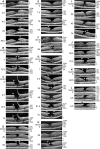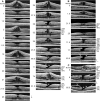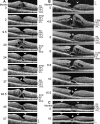Degenerative lamellar macular holes: tractional development and morphological alterations
- PMID: 33433772
- PMCID: PMC8035119
- DOI: 10.1007/s10792-020-01674-0
Degenerative lamellar macular holes: tractional development and morphological alterations
Abstract
Purpose: The development of degenerative lamellar macular holes (DLH) is largely unclear. This study was aimed at documenting with spectral-domain optical coherence tomography the tractional development and morphological alterations of DLH.
Methods: A retrospective case series of 44 eyes of 44 patients is described.
Results: The development of DLH is preceded for months or years by tractional deformations of the fovea due to the action of contractile epiretinal membranes (ERM) and/or the partially detached posterior hyaloid, or by cystoid macular edema (CME). DLH may develop after a tractional stretching and thickening of the foveal center, from a foveal pseudocyst, after a detachment of the foveola from the retinal pigment epithelium, a disruption of the foveal structure due to CME, and after surgical treatment of tractional lamellar or full-thickness macular holes (FTMH). The foveal configuration of a DLH can be spontaneously reestablished after short transient episodes of CME and a small FTMH. A DLH can evolve to a FTMH by traction of an ERM. Surgical treatment of a DLH may result in an irregular regeneration of the foveal center without photoreceptors.
Conclusions: Tractional forces play an important role in the development of DLH and in the further evolution to FTMH. It is suggested that a DLH is the result of a retinal wound repair process after a tractional disruption of the Müller cell cone and a degeneration of Henle fibers, to prevent a further increase in the degenerative cavitations.
Keywords: Fovea; Full-thickness macular hole; Lamellar macular hole; Müller cell cone; Müller glia.
Figures







Similar articles
-
Different modes of full-thickness macular hole formation.Exp Eye Res. 2021 Jan;202:108393. doi: 10.1016/j.exer.2020.108393. Epub 2020 Dec 7. Exp Eye Res. 2021. PMID: 33301774
-
Müller cells and astrocytes in tractional macular disorders.Prog Retin Eye Res. 2022 Jan;86:100977. doi: 10.1016/j.preteyeres.2021.100977. Epub 2021 Jun 5. Prog Retin Eye Res. 2022. PMID: 34102317 Review.
-
Morphology of partial-thickness macular defects: presumed roles of Müller cells and tissue layer interfaces of low mechanical stability.Int J Retina Vitreous. 2020 Jul 6;6:28. doi: 10.1186/s40942-020-00232-1. eCollection 2020. Int J Retina Vitreous. 2020. PMID: 32647586 Free PMC article.
-
Foveal regeneration after resolution of cystoid macular edema without and with internal limiting membrane detachment: presumed role of glial cells for foveal structure stabilization.Int J Ophthalmol. 2021 Jun 18;14(6):818-833. doi: 10.18240/ijo.2021.06.06. eCollection 2021. Int J Ophthalmol. 2021. PMID: 34150536 Free PMC article.
-
Primary Lamellar Macular Holes: To Vit or Not to Vit.J Clin Med. 2022 Aug 28;11(17):5046. doi: 10.3390/jcm11175046. J Clin Med. 2022. PMID: 36078977 Free PMC article. Review.
Cited by
-
Two cases of lamellar macular hole secondary to the rupture of the cystoid inner wall in patients with diabetic macular edema.Int J Ophthalmol. 2025 Aug 18;18(8):1610-1612. doi: 10.18240/ijo.2025.08.26. eCollection 2025. Int J Ophthalmol. 2025. PMID: 40827284 Free PMC article. No abstract available.
-
[Lamellar macular holes-In the center of vitreomacular interface diseases : Pathophysiology, spontaneous courses and treatment concepts].Ophthalmologie. 2024 Jun;121(6):452-461. doi: 10.1007/s00347-024-02054-0. Epub 2024 Jun 6. Ophthalmologie. 2024. PMID: 38842556 Review. German.
-
Pathophysiology of Secondary Macular Hole in Rhegmatogenous Retinal Detachment.Invest Ophthalmol Vis Sci. 2023 Oct 3;64(13):12. doi: 10.1167/iovs.64.13.12. Invest Ophthalmol Vis Sci. 2023. PMID: 37815508 Free PMC article.
-
Quantitative Analyses of Retinal Traction Force and Metamorphopsia in Lamellar Macular Hole and Related Diseases.Ophthalmol Sci. 2023 Apr 7;3(3):100305. doi: 10.1016/j.xops.2023.100305. eCollection 2023 Sep. Ophthalmol Sci. 2023. PMID: 37214763 Free PMC article.
-
Surgical Management of Full-Thickness Macular Holes Spontaneously Arising From Lamellar Macular Holes.J Vitreoretin Dis. 2023 Nov 23;8(1):29-33. doi: 10.1177/24741264231208493. eCollection 2024 Jan-Feb. J Vitreoretin Dis. 2023. PMID: 38223778 Free PMC article.
References
-
- Yamada E. Some structural features of the fovea centralis in the human retina. Arch Ophthalmol. 1969;82:151–159. - PubMed
-
- Gass JDM. Müller cell cone, an overlooked part of the anatomy of the fovea centralis: Hypotheses concerning its role in the pathogenesis of macular hole and foveomacualr retinoschisis. Arch Ophthalmol. 1999;117:821–823. - PubMed
-
- Syrbe S, Kuhrt H, Gärtner U, Habermann G, Wiedemann P, Bringmann A, Reichenbach A. Müller glial cells of the primate foveola: An electron microscopical study. Exp Eye Res. 2018;167:110–117. - PubMed
-
- Bringmann A, Syrbe S, Görner K, Kacza J, Francke M, Wiedemann P, Reichenbach A. The primate fovea: structure, function and development. Prog Retin Eye Res. 2018;66:49–84. - PubMed
MeSH terms
LinkOut - more resources
Full Text Sources
Other Literature Sources

